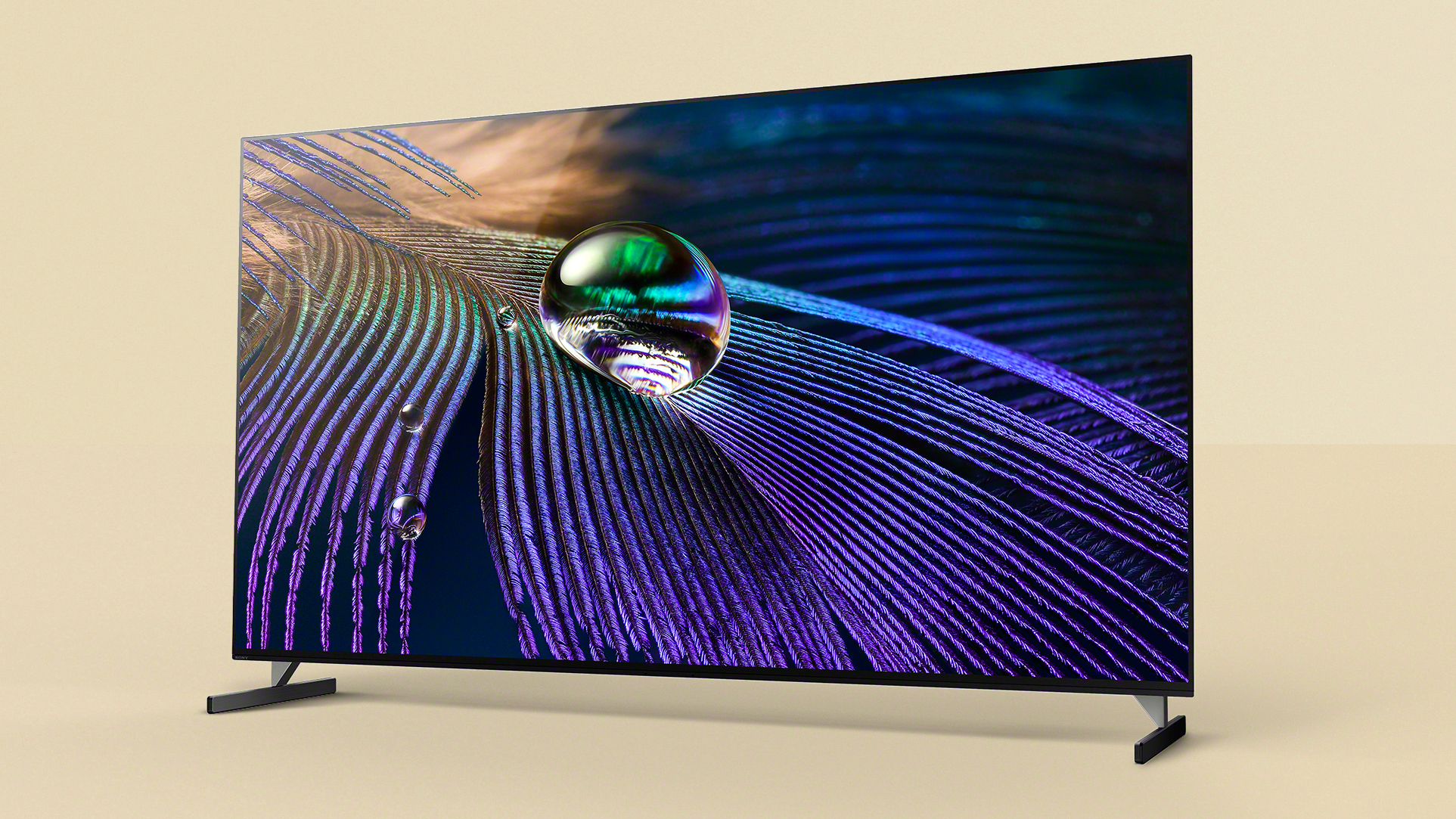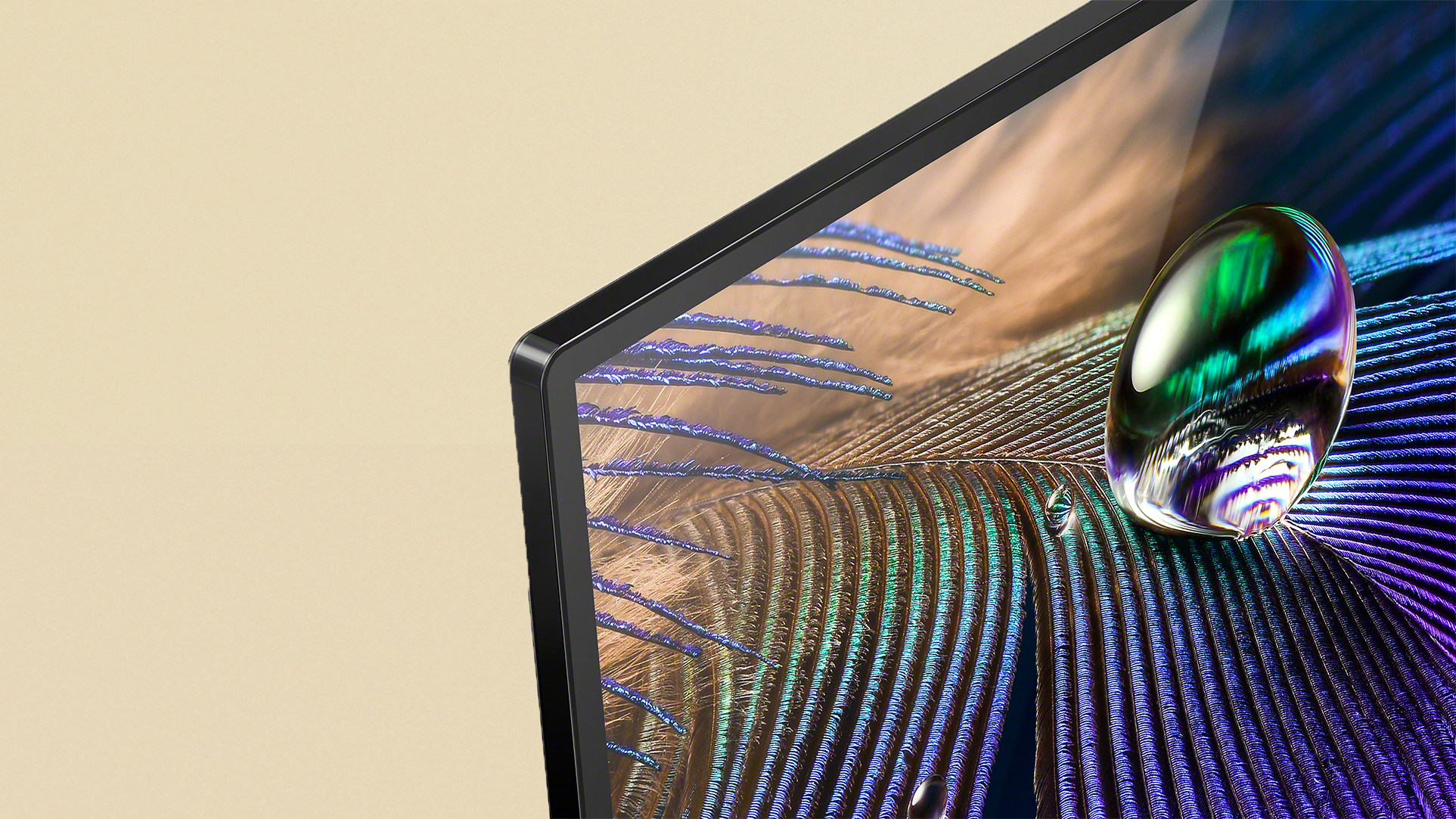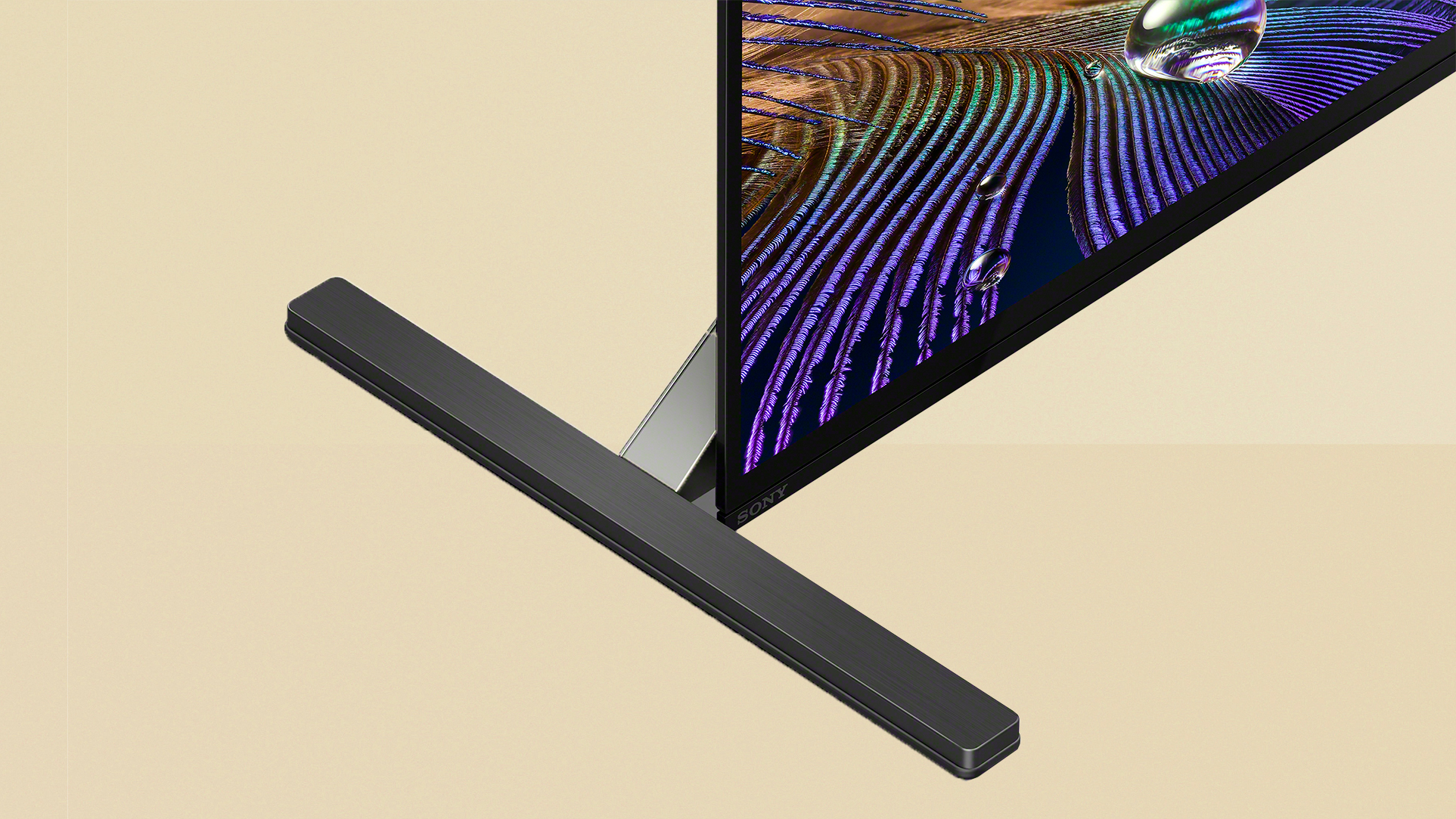Sony A90J review (KD-65A90J): Sony's best 4K TV ever, and an OLED masterpiece
The Sony A90J takes its OLED TVs to a whole new level, with a huge brightness boost and next-gen processing, plus PS5-ready features for the first time


The Sony A90J is a mind-blowing television, offering some of the best HDR performance of any TV so far, matched with Sony's impeccable motion and upscaling processing. It's so vibrant, so rich, so engrossing – it's right at the peak of 4K TVs today. It has some missing features, but they're mostly of interest to gamers – for everyone else, it's simply fantastic.
-
+
Punchiest OLED HDR pictures yet
-
+
Awesome motion and upscaling processing
-
+
Ultra-minimalist design
-
+
Immersive, open sound
-
-
No VRR or 4K/120fps with Dolby Vision
-
-
No Dolby Vision game mode
-
-
Missing UK streaming apps
Why you can trust T3

This Sony A90J review looks at the most elite model in Sony's 4K TV range for 2021, based on a new brighter OLED screen.
Despite not being as philosophically predisposed to see OLED as innately superior to LCD as many rival brands, Sony has still turned out some of the best OLED TVs of recent years. The brand’s ever-impressive picture processing has consistently played very nicely with OLED’s pixel-by-pixel lighting.
The only little consistent niggle I’ve had with Sony’s mostly excellent OLEDs is that they have tended to be a bit cautious with their brightness. Cue much excitement at the arrival of Sony’s new A90J range.
These new flagship sets are Sony’s first to feature new high-brightness OLED panel technology, which use new manufacturing materials and, in Sony’s case, a laminated aluminium heat sink to solve the overheating issue that’s typically such a big factor in limiting OLED brightness.
Sony is not the only brand to offer such technology, though. Panasonic has been selling very premium (see: expensive) high-brightness OLED panels for a couple of years now (including the new Panasonic JZ2000), and LG has introduced new brightness boosting panels on its 2021 LG G1 series.
The idea of what Sony might be able to coax out of its new panels with the assistance of its new Bravia XR processor, though, is pretty mouthwatering. And the set delivers – this was absolutely one of the best TVs of 2021, and still today holds its own amongst the best.
For this test, we're looking at the 65-inch version.
Get all the latest news, reviews, deals and buying guides on gorgeous tech, home and active products from the T3 experts
Sony A90J review: Price & release date
The 55-inch Sony 55A90J costs £2,699/$2,999, while the 65-inch Sony 65A90J we're looking at costs £3,499/$3,999/AU$4,995. There's also an 83-inch Sony 83A90J, which costs £6,999/$8,999/AU$11,499.
These are all price steeply higher than the likes of Sony's own A80J OLED (the model below this one), or the LG G1 – both will save you hundreds, or even up to a thousand.
The A80J doesn’t get that all-important high-brightness panel, though, while LG’s G1 seems to make relatively restrained use of its high-brightness core. They're just not the same…

Sony A90J review: Features & what's new
The brightness boost is easily the big headline here – brightness has always been the one key weakness of OLED TVs, and Sony's sets in particular never really sought to push that in the past.
For instance, while the LG G1 tops out at around 890 nits in its most vibrant Vivid mode and around 750 nits in its Cinema and Filmmaker modes, the A90J gets around 915 nits in Vivid mode and around 790 nits in Cinema Mode. These look like relatively small differences on paper, but as we’ll see, they do matter – especially when married to Sony’s new video processing system.
Some of the A90J’s picture presets, especially Vivid, also seem able to overdrive bright parts of the picture to the point where small very bright HDR areas can fleetingly achieve higher brightness levels than the measured figures given above.
It’s well worth noting, too, that the heat dissipation ‘layer’ of the new A90J panel should mean you can enjoy the screen’s extra brightness without having to worry about it being any more susceptible to permanent image retention in areas of static image content, such as channel logos and game HUDs.
The new video processing I mentioned earlier is Sony’s Bravia XR processor. Sony describes this processor’s approach as ‘Cognitive’, which means, as succinctly as possible, that it breaks each incoming frame down into multiple constituents – colour, contrast, detail, object definition and so on – and then slightly manipulates everything to deliver a final image that more closely resembles the way our eyes perceive the real world.
This includes, in particular, figuring out where the focal points of images are and gently enhancing their relative presence in the overall picture.
Sony additionally claims for the new XR engine general improvements in contrast, colour, motion and the upscaling of sub-4K sources. Particularly intriguing on the colour front is Sony’s claim that its new processor works equally on the red, green and blue colour elements, rather than just manipulating the white element that’s so key to affordable OLED technology. This should hopefully mean that the A90J’s colours don’t become desaturated by the extra injection of brightness they’re getting.
All this talk of powerful image processing may sound alarming to AV purists. But trust me: The Cognitive Processor XR is driven much more by naturalism than any desire to make pictures in any way gaudy. In fact, it’s pretty easy to imagine Sony sitting there tuning the XR processor with the brand’s legendary X300 OLED mastering monitor sat alongside for reference.
The new XR processing doesn’t restrict its hefty brainpower to picture quality. It also joins forces with Sony’s Acoustic Surface technology, where the screen actually functions as the set’s speakers, to place sound effects more accurately, so that they have a more effective balance in the mix, and appear to be coming from the area of the screen that matches the position of the object making the sound.
The new processor can upconvert relatively low quality sound sources to a 3D Surround effect too – all, again, in keeping with an over-riding idea of creating a truly immersive, life-like experience. Sony is so confident about the A90J’s audio capabilities, in fact, that it’s equipped the TV with spring clip audio cable connectors so that you can make it the centre speaker in a wider multi-channel sound system.
Some aspects of the A90J’s functionality aren’t quite as complete as its new processing system seems to be, though. For starters, while the set is capable of handling the Dolby Vision, HDR10 and HLG formats of HDR, there’s no support for the HDR10+ system. Like Dolby Vision, this format adds extra scene by scene picture data that compatible TVs can use to render HDR more accurately (and, usually, more dynamically).
HDR10+ is not nearly as common in the content world as Dolby Vision, but Amazon Prime Video uses it for all of its HDR content, and there’s some support for it on Rakuten – as well as it appearing on a small number of 4K Blu-rays (including Alien!). The Panasonic JZ2000 does support both premium HDR formats, it's worth nothing (though the LG G1 is also Dolby Vision only).
For UK users, it's also worth noting that while I’ve been testing the A90J, it doesn’t currently support the BBC iPlayer app. So it wasn’t possible to use the TV to watch the BBC’s live Euro 2020 streams in 4K HDR. In fact, at the time of writing the A90J doesn’t support the majority of UK catch-up TV apps. As well as the missing iPlayer, there’s no ITV Hub and no All 4. Nor is there any sign of the YouView umbrella app that’s provided all of the UK’s catch-up services on previous generations of Sony TV.
Sony still says it’s going to be adding these services soon – but it’s been saying that for a long time now.
Another key premium TV feature widely available on rival premium TVs not yet supported by the A90J is Variable Refresh Rate gaming. This was first supposed to have been added to 2020’s Sony X90H/X900H, but it still hasn’t arrived. In fact, Sony still can’t promise a definite date for its arrival. It's worth nothing that this feature was promised for the PlayStation 5 and hasn't arrived there either, so perhaps Sony will roll it out to all devices at some ill-defined point in the future.
Two of the HDMI ports, at least, are made to the latest high bandwidth HDMI 2.1 standard, and support 4K in HDR at 120Hz, plus auto low latency mode gaming features. Frustratingly, though, as with previous Sony TVs, you can’t have Dolby Vision and 4K/120Hz at the same time. The HDMI set up menu give you an either/or situation, with HD 120Hz or 4K 60Hz being your only options with Dolby Vision active. With the Xbox Series X now rolling out Dolby Vision in games, including at 120fps, you're potentially missing out here.
It’s also a pity that there’s no Dolby Vision Game mode. This means that if you want to game in Dolby Vision you’ll have to put up with much higher input lag than the mere 16.2ms or so you get when playing in standard HDR with the A90J’s Game mode selected.
There’s also eARC support on HDMI 3, so that you can pass lossless Dolby Atmos and DTS:X out to eARC-compatible soundbars.
The A90J is certified for IMAX Enhanced – a serious rarity in the current TV world. This means its images have been assessed by IMAX as being good enough to deliver the extra picture quality created by the IMAX Enhanced mastering system. IMAX Enhanced content is available, if you're wondering, on a small selection of 4K Blu-rays, plus Rakuten and Sony’s new Bravia Core movie platform.
The big deal with Bravia Core is that it can deliver streams at up to 80Mbps (if you can muster a recommended broadband speed of 115Mbps or more), when the likes of Netflix and Amazon typically top out at between 15 and 20Mbps. And having watched a movie in IMAX Enhanced through the A90J on a 300Mbps connection, I can confirm that Sony doesn’t seem to be exaggerating with its picture quality claims for Bravia Core. It really was the best looking stream I’ve ever seen.
Sony’s smart features/interface are provided by the brand new Google TV platform. This takes over from Android and represents a pretty significant step up in terms of its presentation, organisation, customisation options and, best of all, its ability to start recommending content you might actually like based on your viewing history, rather than just recommendations based on popularity and paid content.

Sony A90J review: Picture quality
The Sony 65A90J’s combination of a new high-brightness panel and sophisticated new processing engine yields pictures that can consistently only be described as breathtaking. Or beautiful. Or maybe breathtakingly beautiful.
The A90J excels in so many picture quality areas that it’s hard to know where to start trying to dissecting things. Since the new high-brightness panel is so key to the A90J’s premium OLED status, though, that’s as good a place to start as any.
It’s instantly obvious that the new panel really has enabled Sony to give its OLED pictures a serious kick up the butt. Bright peaks in HDR sources aren’t just brighter and more intense than they’ve been on any Sony OLED before; they’re brighter and more intense than I’ve seen them on basically other OLED TV.
In fact, thanks to the way OLED technology can place pretty much a full black pixel right next to a full white one without either compromising the other, small bright highlights, such as torches or lamps against a night sky, look more intense and truly dynamic than they even do on much on-paper brighter LCD TVs.
The extra brightness isn’t limited to mere HDR highlights, either. It also makes its presence clearly felt in full-screen bright HDR imagery. There’s a radiance in sun-drenched daylight shots, for instance, that I’d started to think I’d never see from an OLED TV.
As well as objectively giving you a much more HDR experience that even holds up with very aggressively mastered HDR titles, the extra full screen brightness the 65A90J can deliver ensures that you also experience way more of that natural, real world experience that HDR is at heart all about.
At the opposite end of the HDR light spectrum, the A90J delivers black levels every bit as inky and deep as we’ve come to expect from the best OLED TVs. Naturally this combination of extreme light and dark being able to share the screen without issue achieves truly spectacular contrast results.
The A90J’s excellent black levels are superbly stable too, avoiding the flickering instability that you get with some OLED sets. That's despite the presumably bigger challenge of controlling baseline black levels on a significantly brighter panel like the one the A90J is using.
The A90J doesn’t just impress with how deep its black colours can get, though. Also outstanding is how much shadow detail it retains in dark areas. There’s not a trace of black crush, leaving dark scenes looking as full of depth and texture as bright ones. This makes for a fantastically consistent viewing experience, and leaves you convinced that you’re seeing every bit of picture information the director wanted you to see.
Great contrast often leads to great colours, and that’s true of the A90J – with bells on. Sony’s promise to deliver colours richly saturated enough to keep pace with the panel’s high brightness is fully delivered on, as the screen holds on to even the brightest of tones without even a hint of desaturation.
If you want to see just how extreme the 65A90J’s colours can go, give the Vivid preset a go. You likely won’t want to keep using this for long as its intensity actually becomes pretty tiring, but it certainly helps explain why the TV is so comfortable handling even the most vibrant and bright content in the other more natural modes.
The A90J gets great value out of its native 4K resolution, too. The impressive shadow detail in dark areas, subtle colour shading and extremely fine light control helps delineate every pixel of image information in a good 4K source. Sony continues to offer superb motion processing options too, enabling you to remove pretty much as much panel judder and motion blur as you feel comfortable with without having to worry about the processing throwing up unpleasant side effects.
Sony’s XR engine is extremely effective at upscaling HD sources, too. This was always a strong component of the X1 Ultimate engine, but if anything it’s even better on the A90J thanks to the way the new processor is able to detect and subtly distinguish the most important parts of an HD image, helping the object-based upscaling system deliver even more natural, three-dimensional results.
The A90J’s glistening array of picture triumphs make it an excellent gaming display, too. The combination of high contrast, rich colours, good detailing and, by OLED standards, impressive brightness are all perfectly suited to today’s HDR gaming worlds, and the screen feels suitably responsive in its Game mode. The ultra-crisp and smooth majesty of 4K 120Hz gaming is also impeccably delivered.
So good is the 65A90J for gaming, though, that you can’t help but rue the ongoing lack of VRR and high-framerate 4K Dolby Vision support. It could be perfect, but it's missing two of the most promising next-gen features – it's worth noting that you'll find support for both of these in the LG G1 (and LG C1, come to that).
Having finally slipped into negative mode regarding the 65A90J’s pictures, I’d usually now take the opportunity to go into a few other problems. However, problems are pretty hard to find on Sony’s OLED flagship.
As noted earlier, some might wish that Sony had used the new high brightness panel to deliver a more sustained full screen brightness, like Panasonic does with its expensive premium OLEDs, rather than using the brightness to deliver much punchier highlights for short durations of time. But personally I quite like Sony’s dramatic approach.
The screen can dim a little where static image elements appear, for a protracted time, which can be noticeable when gaming. Though not to a degree where I felt it was really letting a game down.
There can also be a little more colour banding in bright, relatively uniform areas of colour when gaming in HDR than I customarily see, and the approach Sony takes to accuracy with its Cinema picture mode sees it clipping detail quite substantially out of the brightest HDR picture areas.
The amount of times the TV keeps pointing out that a particular picture quality change might impact power consumption is quite infuriating too - though I guess this affects me as someone testing the TV’s features out much more than it would a regular user, who’s unlikely to change picture settings all that often.
Let’s finish on the high the A90J so richly deserves, though, by reminding you that as with all OLED TVs (but hardly any LCD TVs), you can watch it from almost any angle without its pictures significantly degrading.

Sony A90J review: Sound quality
The 65A90J’s sound is strong in most ways. Particularly appreciated is the way using the screen as the speakers enables the TV to push sound directly out into your room, rather than everything sounding as if it’s coming from somewhere behind the screen. This makes soundtracks feel more intense, impactful and immersive.
There’s enough dynamic range available to deliver a really open sound, too, that comfortably avoids that thin, compressed feeling associated with many TV sound systems. There’s enough headroom in the sound, as well, to allow it to shift through a decent amount of gears as an action scene builds to a crescendo.
Voices are crystal clear at all times, even though there’s a sense of scale to the sound stage that spreads beyond the screen’s boundaries.
Left and right separation is surprisingly strong considering the screen is being used for most of the sound, and you can at times really hear how the Cognitive XR processing is working to enhance the sound effect placement. The effect is not as impressive as the XR’s picture processing is, but it’s certainly worthwhile.
Perhaps in part because they are found on the TV’s rear, the bass drivers feel a little detached from the main sound action. Also, while they can go deeper without distorting than you might reasonably expect from a TV that’s so super slim over much of its rear, the bass drivers can feel more hemmed in than the rest of the soundstage.
Another issue is that treble details and voices can start to become a little harsh and dominant at high volumes during very dense mix moments.
Overall, though, the A90J sounds better than you’ve a right to expect with such a beautifully designed screen.
Sony A90J review: Design and usability
If minimalism is your thing, you’ll love the Sony A90J. Its 65-inch screen is surrounded by an incredibly thin bezel, while the support feet sit so flat in their ideal extreme bottom corner locations that you barely notice them. Sony describes the look as a ‘minimalist one slate design with a seamless edge bezel’. Which is actually pretty accurate as marketing descriptions go.
The set is remarkably slim around the back too, at least around the screen’s outer edges, adding a futuristic feel to the minimalistic elegance.
It sticks out a more regular distance over a portion of its rear side to make room for the built-in bass drivers, connections and processors. But you only see this from really extreme angles, and in any case the vertical grill effect Sony has applied to the A90J’s rear disguises the extra depth quite nicely.
If you’re looking at the A90J sitting flush to your desktop wondering how you might be able to add a soundbar if you decide the built-in sound system isn’t enough for you, the legs can be attached in such a way that they raise the screen up enough to fit a soundbar underneath.
Moving to the new Google TV smart TV software makes the A90J easier to use than Sony’s previous Android TVs. The onscreen interface is more friendly, customisable and reflective of how people are using TV features nowadays.
Things can still become a bit confusing when it comes to the TV’s detailed settings menus, which don’t feel very well integrated into the interface, and aren’t particularly friendly in their presentation when you get to them. But once most people have completed the initial installation, I guess they won’t need to delve into the advanced setup menus too often.
Sony A90J review: Verdict
Sony has taken full advantage of its new high-brightness panel to deliver not just easily its best OLED TV, but also the most all-round spectacular OLED picture quality to date. Certainly no other OLED TV has delivered such an exciting demonstration of the joys of high dynamic range pictures – at least when it comes to the ‘range’ part of the HDR label.
It’s a pity that at the time of writing the A90J is missing a few notable features. Most of these are still scheduled to arrive via firmware updates at some point, though, at which point the A90J will become even more irresistible than it already is.
Sony A90J review: Also consider
For UK readers, the Panasonic JZ2000 is the big competition. This OLED TV is similarly bright for highlights, and does excellent work with its overall brightness too. It has a Dolby Atmos sound system built in, including upfiring and side-firing drivers, and supports all HDR formats.
The LG G1 isn't quite as bright, and Sony's image processing is just a little ahead of LG's overall, but this fairly-bright OLED is also cheaper and has all the features that the Sony is missing (except for HDR10+). It also has a super-smart design that's built for being wall-mounted (with a special flush bracket). Here's our full LG G1 review.
John Archer has been testing TVs and AV gear for over 25 years, having worked on Home Cinema Choice magazine. He's a contributor to Forbes, TechRadar, Trusted Reviews, Wired and many more places – if you've owned a TV in the last couple of decades, John's probably reviewed it somewhere. He's seen so many hot new technologies come and go, like tears in the rain.
